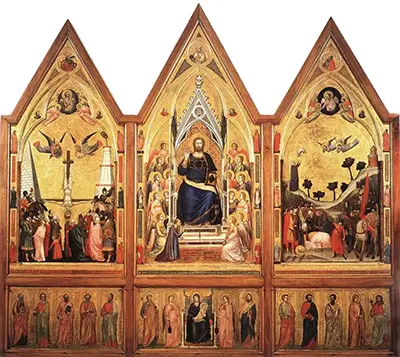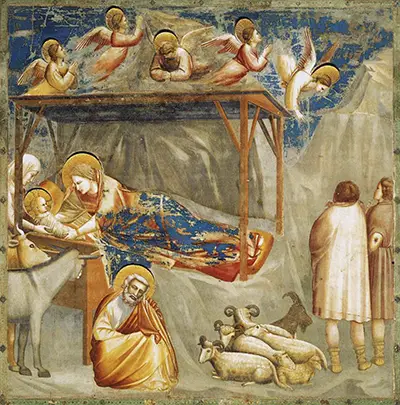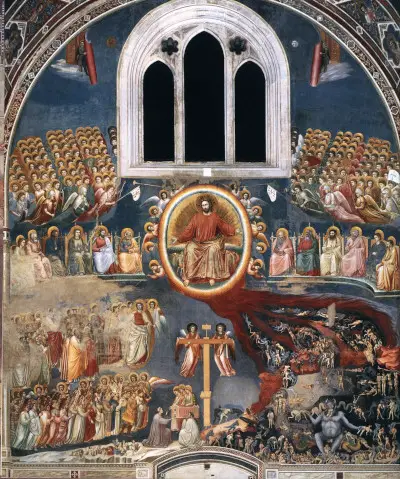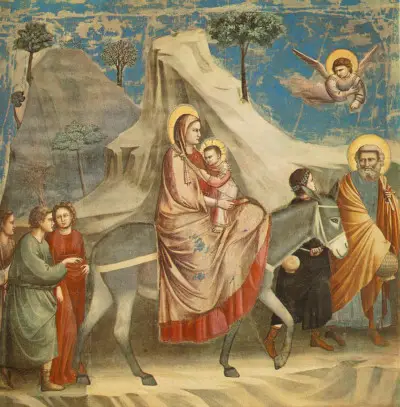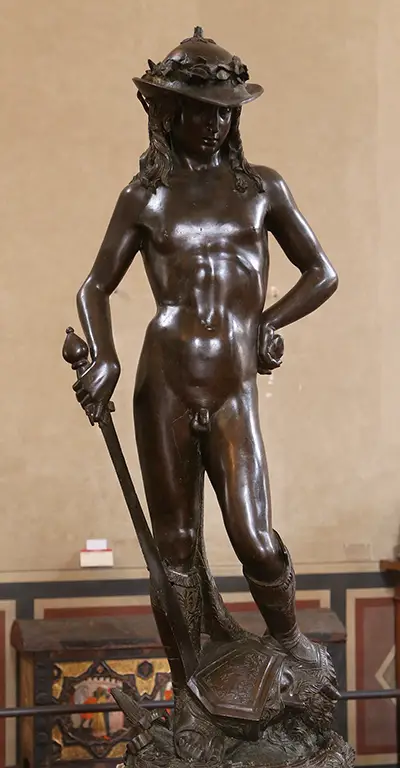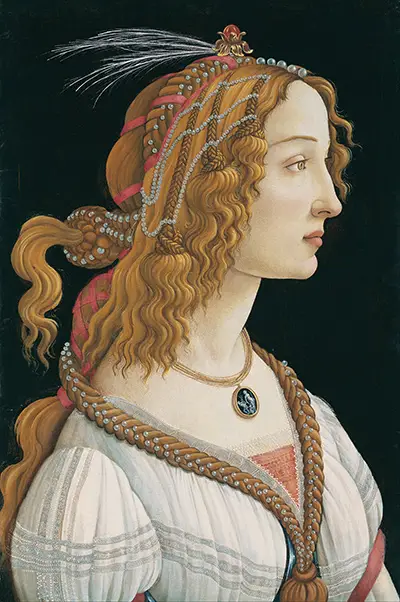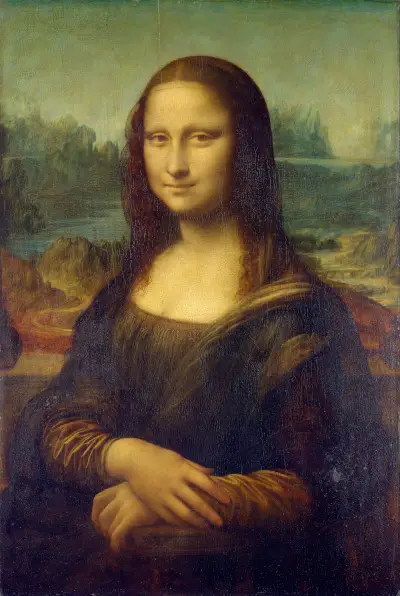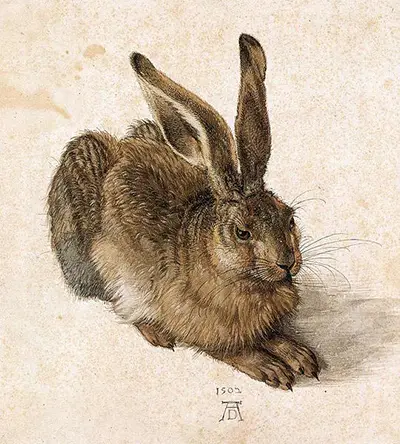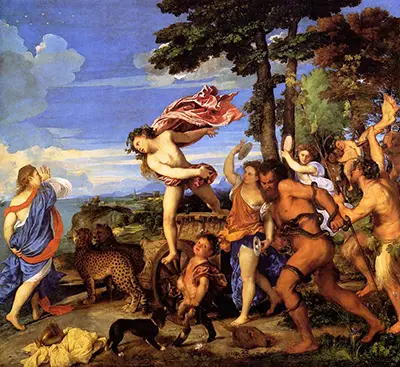Giotto's Adoration of the Magi shows the portal of Bethlehem, Saint Joseph, the Virgin and child, the three wise men (the Magi), two camels, two pages, the archangel and what's believed to be Haley's comet. In keeping with previous iconography, of the three Magi one is old, one is middle aged, and one is younger.
This is just one of the scenes painted by Giotto in the Scrovegni Chapel, a small church located on the property of the Degli Ermimitant Monestary in Padua, Italy. The chapel in and of itself is one of the great jewels of the 14th century, and no trip to Italy can be sid to have been complete without a visit to these hallowed grounds. The frescoes of Giotto that adorn the Scrovegni Chapel are especially impactful, and not even the best, most high-resolution photograph can ever replicate the experience of seeing them in person. The intense blue found in Adoration of the Magi and Giotto's other frescoes is the result of pigment made primarily from azurite, a mineral found in the mountains of Germany, France, Hungary, Greece and throughout the old Roman Empire.
More than any other artist, Giotto is responsible for the move away from gothic painting to the renaissance. In contrast to the painters that came before him, Giotto gave volume to his figures. For instance, whereas the figures painted by Cimabue, Duccio and other Byzantine masters were heavily stylized and elongated, Giotto's were much more realistic. Nor were they were festooned with drapery that magically swirled around them; instead, Giotto's realistic figures were clothed in equally realistically rendered garments that hang from their bodies naturally, and that gave them dimensionality and weight. We can also observe how the halos are placed around the figures' heads. Whereas previously the tenendency had been to show them as flat plates seen from the front, here they also conform to the figure to show perspective and depth.
This is not to say that Giotto's paintings are photorealistic. For instance, here in the Adoration of the Magi we can see that despite its more accurate perspective and the improved realism of the figures, there are still aspects of the work that disqualify its realism. For starters, the mountainous rocks in the background are disproportionately small when compared to the figures. What's more, these same rocks and the tunics the figures are wearing appear to have the same texture. The camels in the piece are almost cartoon like with their anthropomorphic expressions. Nonetheless, Adoration of the Magi along with the other frescos at Scrovegni chapel represent a huge leap forward in the art world.
Table of Contents
- Description of the Painting
- What Artistic Techniques did Giotto use in this Artwork?
- What is the Meaning of the Adoration of the Magi?
- How Many Depictions of the Adoration of the Magi did Giotto Paint?
- Where can this Painting be found Today?
- What other Paintings can be found in the Scrovegni Chapel?
- Information on Visiting the Chapel in Padua
- Which other Artists have also covered this theme?
- When was the Adoration of the Magi first used in Art and Design?
- Large Image of The Adoration of the Magi
Description of the Painting
Christians will be able to identify every item found within Giotto's Adoration of the Magi. We find the Kings themselves, worshipping the new born baby. They are of different ages, which was how they became depicted in western art from around the 10th century. We then find two camels to the left hand side, some pages, plus Saint Joseph, the archangel and the virgin and child themselves. In the distance are several rocky mountains, some of which have been won away in the years that have passed since the fresco was first completed. The key figures are represented by golden halos, which was a common technique used by Giotto throughout his religious art. He is likely to have drawn the original design before calling on help to implement the work over plaster from his many assistants. By overseeing the whole project, Giotto was able to ensure a consistent look across the full cycle of frescoes which can be found on the interior walls of the Scrovegni chapel.
What Artistic Techniques did Giotto use in this Artwork?
Giotto would use tempera and fresco techniques within his career, but all of his work within the chapel derived from the latter. The artists would work as the plaster dried, and the reaction between the application and the plaster would create each artwork. It would be impossible for Giotto to do all of this himself, with timing of each artwork being highly important, and so he called upon a large number of assistants who could help to implement his original designs. The use of fresco is ideally suited to large scale projects such as this, but one of the downsides is that to move them elsewhere would be a particularly difficult task, which is why so many Italian frescoes still remain within their original locations, all these years later. Frescoes are a particular type of mural, with is a style of art which itself can be completed in many other mediums as well.
What is the Meaning of the Adoration of the Magi?
This theme is also sometimes known as the Adoration of the Kings. The Bible, Matthew 2:11 reveals that, "On entering the house, they saw the child with Mary his mother; and they knelt down and paid him homage. Then, opening their treasure chests, they offered him gifts of gold, frankincense, and myrrh. And having been warned in a dream not to return to Herod, they left for their own country by another path". The scene features the Nativity of Jesus, where the three Magi follow a star to find Jesus. They then give gifts and worship him upon arriving. The meaning of the topic is that Christ's significance was understood immediately. The event is commemorated at different times, but different versions of Christianity, though all in either December or January each year.
How Many Depictions of the Adoration of the Magi did Giotto Paint?
Giotto di Bondone is known to have produced two different versions of the Adoration of the Magi. The item featured here was a part of the cycle of paintings for the Scrovegni Chapel, but he also produced another version between 1320 and 1325 which can be found in the Metropolitan Museum of Art in New York. That work is sometimes known instead as The Epiphany in order to differentiate the two and the layout of each painting is fairly similar. The latter remains in remarkably good condition and perhaps has benefited from being stored within a more modern setting, where more precise preservation techniques can be used. Its colours, for example, are in particularly good order, with the original tones of red, blue and pink still being visible today.
Where can this Painting be found Today?
The Scrovegni Chapel in Padua, Italy hosts this artwork, alongside a large number of other pieces by Giotto di Bondone. The Adoration of the Magi is to specifically be found on the middle tier of the south wall. It sits alongside The Nativity of Jesus, The Presentation of Jesus at the Temple, The Flight into Egypt and The Massacre of the Innocents. The overall cycle found throughout the chapel recall scenes from the Life of Christ and the Life of the Virgin, which were commonly seen during this period in Italian art. Besides paintings such as this, the same themes would also appear within sculpture and architecture too, with religion having a massive influence on the content of Italian art during the 13th, 14th and 15th centuries. Most artists would normally be tasked with choosing a particular passage for each project, but sometimes, as seen here, they would be allowed to cover a whole series of connected stories which could decorate whole rooms or buildings.
What other Paintings can be found in the Scrovegni Chapel?
The chapel was recently designated a UNESCO World Heritage Site, mainly due to the beauty and significance of the fresco cycle found within this building. Giotto would make use of a large team of assistants in order to create individual paintings that were focused on well known themes from the Life of Christ and the Life of the Virgin. Lamentation, Kiss of Judas, Nativity and The Flight into Egypt are some of the more memorable items to be found here, but the total contribution runs into several dozen. Besides these pieces, the chapel also features fourteen personifications in grisaille which refer to figures of vice and virtue. Giotto is believed to have worked on all of these as well, but they tend to receive less attention than the other, more colourful cycle devoted to the life of Christ and the Virgin.
Information on Visiting the Chapel in Padua
The chapel itself features on many Italian tour itineries and this is likely to continue now that Padua has been backed by the UNESCO World Heritage organiation. The city is located in the Italian province of Veneto in northern Italy and is not too far from Venice. The chapel remains open to visitors, regardless of their faith, and it continues to receive a steady stream of tourists all year round. As with any historical architecture such as this, numbers always have to be managed in order to avoid any deterioration to the building itself or the art itself, but the slightly rural location of Padua ensures that most international tourists will actually remain elsewhere in the cities of Florence, Rome and Venice. Local and national governments will also go to great lengths to protect their cultural heritage, and preserve this important location for future generations.
Which other Artists have also covered this theme?
The theme of the Adoration of the Magi has been used countless times across North European and Italian art. It would be impossible to include them all here, with some still being attributed to anonymous artists. The most famous contributions, besides Giotto's, would be the likes of a triptych by Hieronymus Bosch, a collaborative piece from Fra Angelico and Filippo Lippi and also one by Pieter Bruegel the Elder. In truth, almost all of the major artists from these two regions would tackle this theme at some point in their careers, leaving an impressive selection of art to compare and contrast from across a period of several centuries. Giotto's work here is generally discussed as a part of his overall work within the chapel, and so does not receive much specific attention itself, which can be said for all of the components within this cycle.
When was the Adoration of the Magi first used in Art and Design?
The earliest artworks based on this theme date to around the 4th century and were used in decorative pieces for catacomb paintings and sarcophagus reliefs. Persian and Mediterranean content would be used at the time, but in the centuries that followed the Adoration of the Magi would evolve in style and content, despite the original inspiration remaining the same. Items such as crowns would start to appear and also the ages of the Magi would vary, covering three different generations when originally the three figures would be of the same age. At time moved forwards, the use of the theme within mainly sculpture would be replaced with painting instead as the prominent medium and that continued throughout the 13th to 15th century. Aside from that, music and stained glass have also used this theme for inspiration, albeit on a lesser scale. When viewing the full breadth of interpretations, one can get a visual guide as to the variations between art from different regions and ages.
Large Image of The Adoration of the Magi

More Renaissance Artists




 Giotto.jpg)
 Giotto.jpg)
